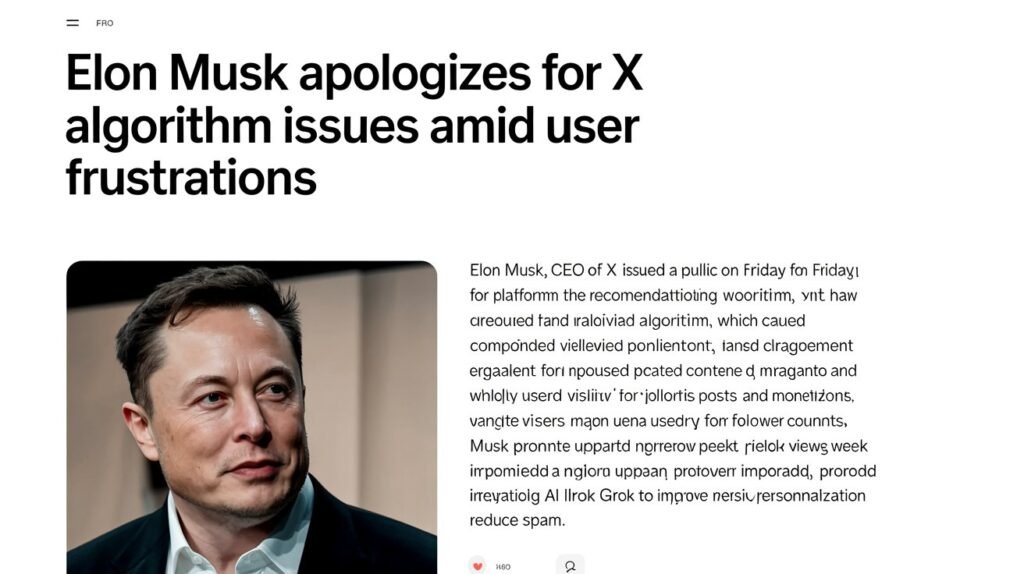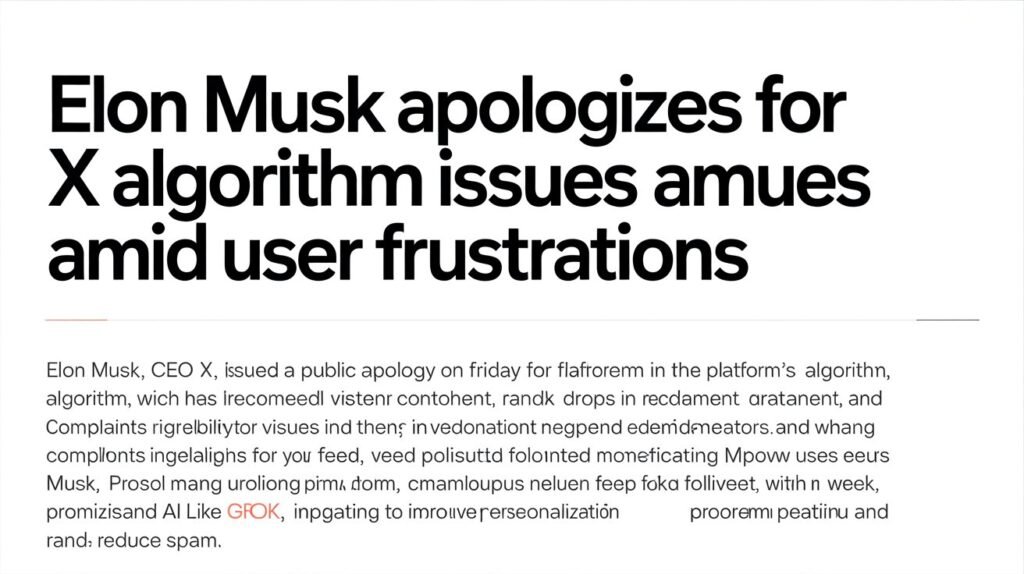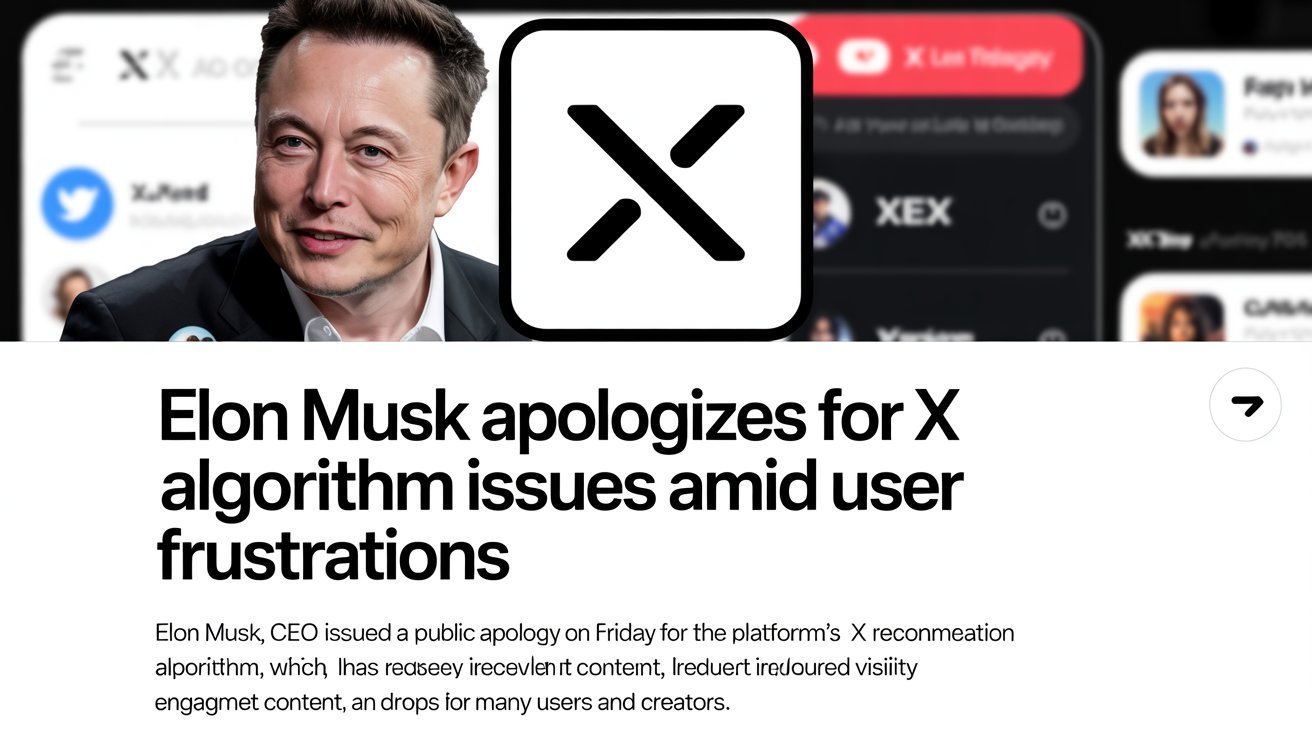On Friday, Elon Musk — the CEO of X and high-profile owner of the platform formerly known as Twitter — issued a public apology acknowledging widespread issues with X’s recommendation algorithm. He wrote:
“My apologies for frustrations with the 𝕏 algorithm. We are working hard to fix the problem.”
This statement comes amid a growing chorus of complaints from regular users and content creators alike, who say that the algorithmes on X are delivering reduced visibility, irrelevant content, and major drops in engagement. Many report that their posts are not reaching their normal follower base, that the “For You” feed has become a source of unwanted political posts, and that monetisation opportunities have taken a hit.
Musk promises a major upgrade next week — citing integration of advanced AI tools (including his own AI firm’s chatbot named Grok) to improve personalisation and reduce spam. This article explores what’s going wrong, what Musk and X are promising to fix, why this matters for users and creators, and what the broader implications are.
What are the complaints about the X algorithm?
Loss of visibility for users and creators
Many users on X report that their posts are reaching far fewer people than usual. Some creators claim that their view counts are far below what they might expect given their follower counts. This suggests that the algorithm is not surfacing their posts in the feed the way it used to. Complaints include:
- Posts getting little to no engagement despite large followings.
- The “For You” feed showing content that is irrelevant, off-topic or heavily political.
- A sense of being “shadow-banned” without formal explanation.
These complaints have mounted in recent weeks and prompted Musk to respond publicly.

Inappropriate content and political spill-over
Another cluster of complaints centres around the appearance of unwanted political posts and spam in users’ feeds. Some users say that content they neither follow nor engage with is being amplified — especially political or polarising posts. The algorithm, as they say, is behaving in unpredictable ways and prioritising “engagement” over relevance or user choice.
Monetisation and creator impact
For creators who rely on visibility and engagement to monetise their content (via sponsored posts, affiliate links or community growth), the algorithmic drop has real financial implications. Lower reach means fewer opportunities to convert followers into action. Some creators have reported that their monetisation metrics have been negatively impacted by unexplained algorithm changes.
Lack of transparency
A recurring theme is that users and creators feel left in the dark. They receive no communication on why their reach has dropped, or what they might do to restore it. That sense of opacity and lack of control has amplified frustration.
Why does this matter? The importance of the recommendation algorithm
The recommendation algorithm (the system that decides what posts to show you, how often, and in what ranking) is at the heart of what a social media platform like X delivers. Why is it so critical?

- Reach → visibility: For creators, brands, influencers and even ordinary users, algorithmic reach determines whether their content is seen or buried.
- Engagement: Platforms are built on the assumption that users want relevant, interesting content. If the algorithm serves irrelevant or unwanted items, engagement drops.
- Monetisation: Lower engagement often means lower ad revenue, fewer brand deals, fewer clicks or conversions.
- User satisfaction and retention: If users see content they don’t care about — or find the feed unpredictable — they may spend less time on the platform or even leave.
- Platform integrity and trust: The more opaque and inconsistent the algorithm, the more users feel manipulated or forgotten. That undermines trust.
Research in the field of social-media algorithms underscores this. For instance, a 2024 study titled Cross-platform impact of social media algorithmic adjustments on public discourse found that changes to a platform’s recommender can boost visibility for certain accounts — but also backfire by triggering negative user reaction or loss of trust.
Given that X is competing for user attention (and advertiser budgets) in a crowded field, algorithmic issues are not minor. They can undermine the value proposition for creators and advertisers alike.
What has Elon Musk and X said will happen?
In his post, Musk promised that the algorithm problems are “being worked on hard.” He also signalled a major upgrade arriving next week, with improvements to personalisation and reduction of spam.
Key points of the fix plan include:
- Integration of AI-based enhancements: Musk referenced the use of AI (notably his AI initiative, xAI and its chatbot Grok) in helping deliver more personalised feeds and better content ranking.
- Better relevance and fewer unwanted posts: The upgrade aims to reduce the number of irrelevant or unwanted posts (especially political/spam) in the “For You” feed.
- Improved transparency for creators: Though the details are light, there is an implicit acknowledgement that creators need better signals (why their posts are seen or not).
- Commitment to addressing spam and algorithmic dysfunction: Musk’s apology and public acknowledgement is a step toward acceptance of responsibility.
It remains to be seen how well these promises will be delivered — and how quickly. Given the scale of the platform and the complexity of algorithmic systems, delivering meaningful change quickly is non-trivial.
Why this troubles matters for creators, brands and users
For creators
Creators build audiences, engagement and brand value based in part on predictable algorithmic behaviour. When the algorithm changes unpredictably:
- Posts may not surface to followers, hurting growth.
- Sponsored or affiliate deals tied to views/engagement may suffer.
- Efforts to build community can stall if users don’t see posts.
Creators should watch their analytics closely, keep back-up channels (e.g., email lists), and engage their following outside of the platform to reduce algorithm risk.
For brands and advertisers
Brands rely on platforms like X to reach their target audience. If visibility drops or becomes inconsistent:
- ROI on ads may decline.
- Campaign targeting may under-perform if users aren’t receiving posts as expected.
- The brand’s reliance on “organic reach + paid boost” can be undermined.
Brands may require more robust monitoring, diversified platform presence, and direct audience development (owned channels) rather than 100% reliance on a single feed algorithm.
For everyday users
If the feed becomes less relevant, or is dominated by unwanted content, user satisfaction falls. That may lead to lower usage, switching to other platforms, or reduced time spent — ultimately impacting the platform’s economics. Users frustrated by the algorithm may feel less “heard” and less in control.
Platform health and competition
For X, maintaining a healthy, functioning recommendation system is vital to compete with other social platforms (Meta’s Instagram, TikTok, etc.). Algorithm issues threaten user retention, content creator loyalty, and advertiser confidence — all of which could drive users or budgets elsewhere. Musk’s public acknowledgement is thus not just about complaints — it’s about preserving the platform’s competitive viability.
What might be the underlying causes?
While Musk’s apology does not lay out detailed technical diagnostics, there are some plausible causes based on what users are reporting, what research shows, and the dynamics of algorithmic systems. Some possible root causes:
- Algorithmic updates gone wrong: Every time a platform tweaks how it ranks or surfaces content, there is risk of unintended side-effects. If X recently modified its model to prioritise “engagement” over “relevance”, that may explain spikes in irrelevant or polarising posts.
- Feed model drift or data shift: If user behaviour (what users follow, what they click, time spent) changes, the existing recommendation model may become stale or mis-calibrated.
- Spam, bots and low-quality content increase: If spammy content or bot activity increases, the algorithm may surface more low-quality posts, which reduces trust and engagement for normal users.
- Lack of creator feedback/visibility: If creators don’t receive signals from the platform (what works, what doesn’t), they cannot adapt to the new algorithm, and their reach drops.
- Excessive political/interest skew: If the algorithm picks up signals that certain posts drive engagement — e.g., political content, controversy — it may over-amplify those posts even where they are not relevant to a user.
- Technical or infrastructure instability: Platform-wide changes, scaling issues, or bugs can degrade recommendation accuracy.
- Transparency/communication gap: The platform may have made changes without clearly informing users or creators, leading to perception of “shadow-ban” or unpredictability.
Research shows that even well-designed algorithmic systems can suffer from these vulnerabilities.
What should users, creators and brands do right now?
Given the current state of flux, here are recommended steps for different stakeholders:
For creators
- Monitor your analytics carefully: track reach, engagement, impressions, follower growth.
- Diversify your audience and distribution: don’t rely solely on X’s algorithm. Use email newsletters, other social platforms, direct outreach.
- Engage actively with your followers: ask questions, spark discussion — algorithmic relevance often rewards engagement.
- Stay informed about any updates from X or Musk.
- Experiment with content formats: if algorithm change means old formats suffer, test new approaches.
- If you depend on sponsored posts tied to views, communicate with sponsors about potential algorithmic risk.
For brands and advertisers
- Review ad performance data and compare against historical behaviour.
- Keep some budget flexibility: if organic reach drops, you may need to invest more in paid or other platforms.
- Build your own owned channels (email, site traffic) so you are less dependent on algorithm changes.
- Stay alert for any announcements from X — major algorithm updates may impact campaign planning.
- Consider A/B testing content formats and audiences given the uncertainty.
For everyday users
- Be aware that your feed may change: if you are seeing more irrelevant posts, use features (if available) to adjust your feed or preferences.
- Provide feedback: if X gives you options to mark “not interested” or adjust topics, use them — algorithm models improve with user signals.
- Consider balancing your social-media usage: if one platform is delivering lower value, experiment with alternatives.
For platform watchers / analysts
- Treat this as an important case study: how a large social-media platform responds publicly to algorithmic dysfunction.
- Watch for how the promised upgrade (next week) is delivered and whether metrics improve (reach, engagement, creator sentiment).
- Observe whether algorithm changes favour certain types of content (political, sensational) or whether the promised “reduce spam” outcome is realised.
What could be the implications long-term?
The apology and algorithm mis-step may have several longer-term implications for X, for Musk, and for the broader social-media ecosystem:
Reputation and trust
By openly acknowledging the issue, Musk may restore some trust — but the key will be whether change is delivered. If problems persist, trust may erode further, especially among creators and advertisers.
Creator migration and platform loyalty
Creators who feel they cannot rely on algorithmic reach may migrate to other platforms (e.g., TikTok, Instagram, YouTube). This could diminish X’s content ecosystem and make it harder for X to attract brand dollars.
Platform competitiveness
X is competing not just on being a micro-blogging network but also as a dynamic content platform (feeds, recommended posts, creator monetisation). Algorithmic dysfunction weakens its competitive posture.
Monetisation & ad revenue
If engagement drops broadly, advertiser interest may decline, which in turn affects platform revenue. To sustain itself, X needs high engagement and demonstrable value to advertisers.
Regulatory scrutiny
Algorithmic transparency (or the lack thereof) is increasingly under scrutiny from regulators around the world. For example:
- The European Commission has demanded X hand over internal documents about its recommendation algorithm.
- French prosecutors opened an investigation into X’s algorithm for potential distortion of automated processing systems.
So any major algorithmic failure may invite regulatory risk, legal liabilities, or mandated audits.
Algorithm transparency and “algorithmic governance” discourse
This episode feeds into broader debates on how social-media algorithms are managed, audited and regulated. It raises questions such as: who governs algorithmic changes? How transparent should the platform be? And how accountable?
What to watch next: key milestones and signals
Here are some indicators to monitor in the coming weeks to gauge whether X’s promised upgrade is actually delivering:
- Official update release timing: Musk promised “a major upgrade next week” — watch for the date and scope of that upgrade.
- Creator-reach metrics: Do creators report improved reach? Are engagement and view counts returning to prior levels?
- Feed relevance feedback: Are users seeing fewer irrelevant or unwanted posts (spam/political) and more content aligned with their interests?
- Transparency/communication from X: Does X provide a deeper explanation of what changed in the algorithm, or a creator dashboard/insight feature?
- Advertiser response: Are advertisers continuing to invest? Are ad rates or CPMs stabilising?
- Regulatory signals: Are there any investigations or regulatory disclosures triggered by the algorithm change or failure?
- Competitive shifts: Are creators or users migrating away from X to other platforms? Are there public departures citing algorithm issues?
- Community sentiment: What is the user sentiment on X itself about the feed quality now? Are complaints dropping or continuing?
FAQ (Frequently Asked Questions)
Q1: What exactly did Elon Musk apologise for?
He apologised for user frustrations with the X algorithm — specifically, that many users and creators are seeing reduced visibility, irrelevant content in their feeds and drops in engagement.
Q2: What is the “algorithm issue” on X?
The algorithm issue relates to how X’s recommendation system is selecting and ranking content for users’ feeds. Complaints include: posts not reaching followers, “For You” feed showing unwanted or off-topic content, creator reach dropping, and monetisation suffering. The root causes are not fully disclosed.
Q3: Why is this a big deal for creators?
Creators rely on reach, engagement and visibility to grow audience and monetise. If the algorithm stops surfacing their content, they lose followers, views and revenue opportunities.
Q4: What is X doing to fix it?
Musk announced that a major upgrade is forthcoming (next week) and that X will integrate advanced AI (including Grok) to improve personalisation and reduce spam/unwanted posts. The exact technical details are still to be made public.
Q5: When will the fix happen?
Musk indicated “next week” from his apology. Users will need to monitor for official announcements or changes.
Q6: Can users or creators do anything now?
Yes. Creators should monitor analytics, diversify platforms, engage more actively with followers and experiment with content formats. Users can provide feedback on their feed, mark unwanted content, and adjust settings if available.
Q7: Could this lead to regulatory problems for X?
Yes. There are existing investigations in Europe into X’s algorithmic practices (e.g., Belgian/European Commission demands) and France has opened a probe into whether X’s automated processing distorts discourse.
Q8: What could happen if X doesn’t fix the algorithm effectively?
Potential outcomes include: loss of creator trust and migration to other platforms, advertiser budget withdrawal, drop in user engagement and time-spent, reputational damage, increased regulatory scrutiny and competitive disadvantage.
Q9: How should brands respond?
Brands should closely monitor performance metrics, ensure they don’t over-rely on X for reach, diversify platforms, invest in owned audiences (email, website) and be prepared for algorithmic shifts.
Q10: Will this algorithm fix guarantee increased reach?
No guarantee. Any algorithmic system is complex, and results may vary. However, better personalisation and fewer unwanted posts should increase relevance, which is a positive step. Creators will still need to engage smartly.
Final thoughts
Elon Musk’s public apology for the algorithm issues on X marks an important inflection point for the platform. It signals that the complaints from users and creators are being taken seriously — but the true test will be delivery of meaningful improvements and transparency.

For creators and brands, this is a moment of both caution and opportunity. Algorithmic instability can be a risk — but if handled well, early adaptation can yield competitive advantage.
For everyday users, it’s worth knowing that algorithms aren’t flawless. Your feed might change, and you may need to play a more active role in shaping it (providing feedback, adjusting topics, exploring alternatives).
Finally, for digital-media watchers, this episode underscores the growing importance of algorithmic governance, transparency and accountability in social media. As platforms increasingly serve as gatekeepers of discourse, their algorithmic decisions have real-world consequences — for creators, users, society and regulation.
We’ll keep a close eye on how the promised upgrade unfolds next week, how creator reach and engagement evolve, and whether X manages to regain trust from its ecosystem.
